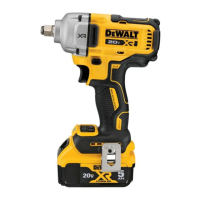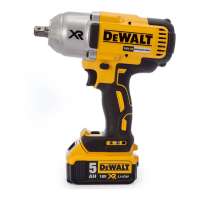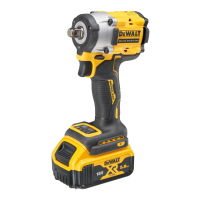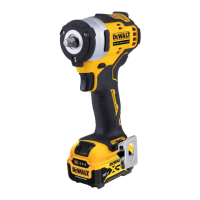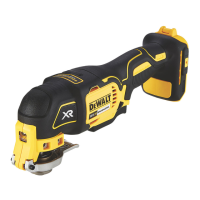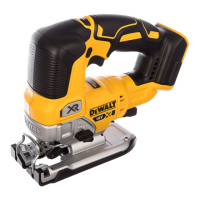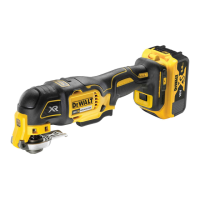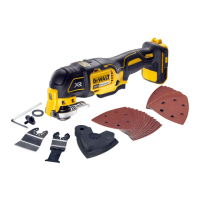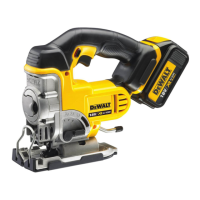11
ENGLISH
Usage (Fig.A, D)
WARNING: To reduce the risk of serious personal
injury, turn unit off and remove the battery pack
before making any adjustments or removing/
installing attachments or accessories. An accidental
start‑up can causeinjury.
WARNING: The ratchet may stall if overloaded causing
a sudden twist. Always expect the tool to twist. Grip the
ratchet firmly to control the twisting action and avoid
possible personalinjury.
CAUTION: Ensure fastener and/or system will withstand
the level of torque generated by the tool. Excessive torque
may cause breakage and possible personalinjury.
Cat # RPM Ft.-Lbs. Nm
DCF512 0–250 0–70 0–94.91
DCF513 0–250 0–70 0–94.91
1. Install appropriate accessory onto the anvil
2
.
2. Place the accessory on the fastenerhead.
3. Consider the intended operation and select either forward
or reverserotation.
4. Press variable speed trigger switch
1
to start operation.
5. Release variable speed trigger switch
1
to stopoperation.
6. If the ratchet stalls, the tool is overloaded or is being
improperly used. Release the variable speed trigger
switch
1
immediately. Do not press the variable speed
trigger switch
1
on and off in an attempt to start a stalled
ratchet. Doing so can damage thetool.
Worklight (Fig.A)
There is a worklight
6
located on the underside of the tool.
The worklight is activated when the trigger switch is depressed.
When the trigger is released, the worklight may stay illuminated
for up to 20seconds.
NOTE: The worklight is for lighting the immediate work surface
and is not intended to be used as aflashlight.
Lock-off Button (Fig.A)
To lock the tool, slide the lock‑off button
8
to the locked
position. When the lock‑off button is in the locked position, the
tool is locked and the trigger switch
1
cannot bepulled.
Optional Accessories
WARNING: Since accessories, other than those offered
by DeWALT, have not been tested with this product, use
of such accessories with this tool could be hazardous.
To reduce the risk of injury, only DeWALT‑recommended
accessories should be used with thisproduct.
Consult your dealer for further information on the
appropriateaccessories.
Cleaning
WARNING: Electrical shock and mechanical hazard.
Disconnect the electrical appliance from the power source
beforecleaning.
WARNING: To ensure safe and efficient operation,
always keep the electrical appliance and the ventilation
slotsclean.
WARNING: Never use solvents or other harsh chemicals
for cleaning the non‑metallic parts of the tool. These
chemicals may weaken the materials used in these parts.
Use a cloth dampened only with water and mild soap.
Never let any liquid get inside the tool; never immerse any
part of the tool into aliquid.
Ventilation slots can be cleaned using a dry, soft non‑metallic
brush and/or a suitable vacuum cleaner. Do not use water or
any cleaning solutions. Wear approved eye protection and an
approved dustmask.
Lubrication
Your power tool requires no additionallubrication.
MAINTENANCE
Your power tool has been designed to operate over a long
period of time with a minimum of maintenance. Continuous
satisfactory operation depends upon proper tool care and
regularcleaning.
WARNING: To reduce the risk of serious personal
injury, turn tool off and disconnect battery pack
before making any adjustments or removing/
installing attachments or accessories. An accidental
start‑up can causeinjury.
The charger and battery pack are notserviceable.
Forward/Reverse Dial (Fig.E)
A forward/reverse control dial
3
determines the rotational
direction of thetool.
• To select forward rotation (clockwise), release the trigger
and rotate the forward/reverse dial
3
on the head of
thetool in a counterclockwisedirection.
• To select reverse rotation (counterclockwise), release the
trigger and rotate the forward/reverse dial
3
on the head of
thetool in a clockwisedirection.
NOTE: The first time the tool is run after changing the direction
of rotation, you may hear a click on start up. This is normal and
does not indicate aproblem.
7. The ratchet can also be used manually for starting stubborn
fasteners or snugging by releasing the trigger and applying
the torque byhand.
NOTE: Excessive manually applied torque may damage the
tool housing ormechanism.

